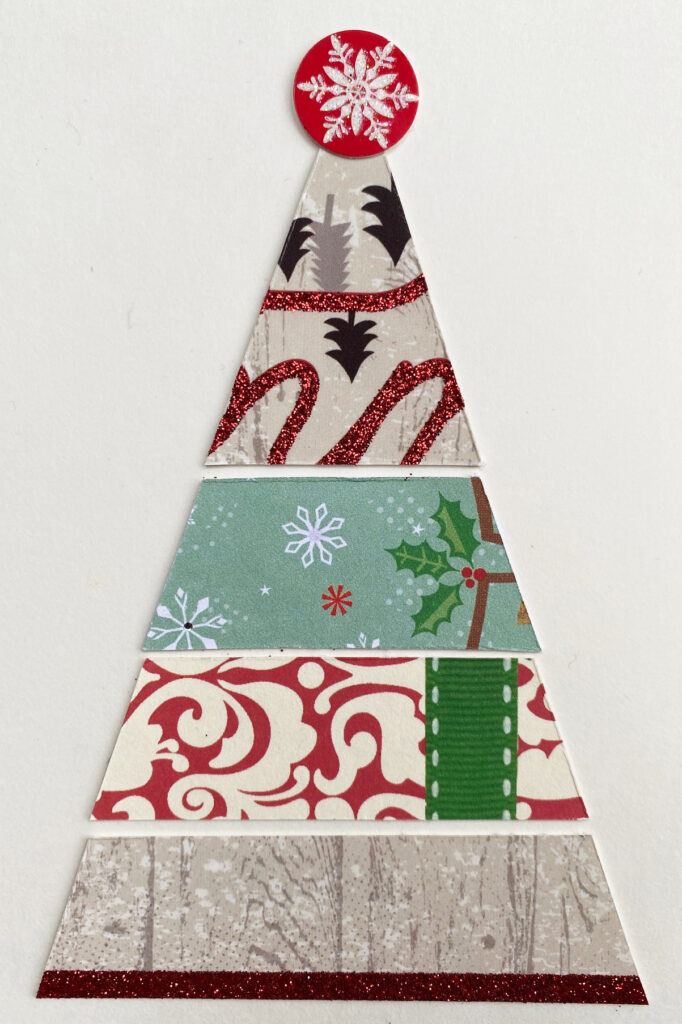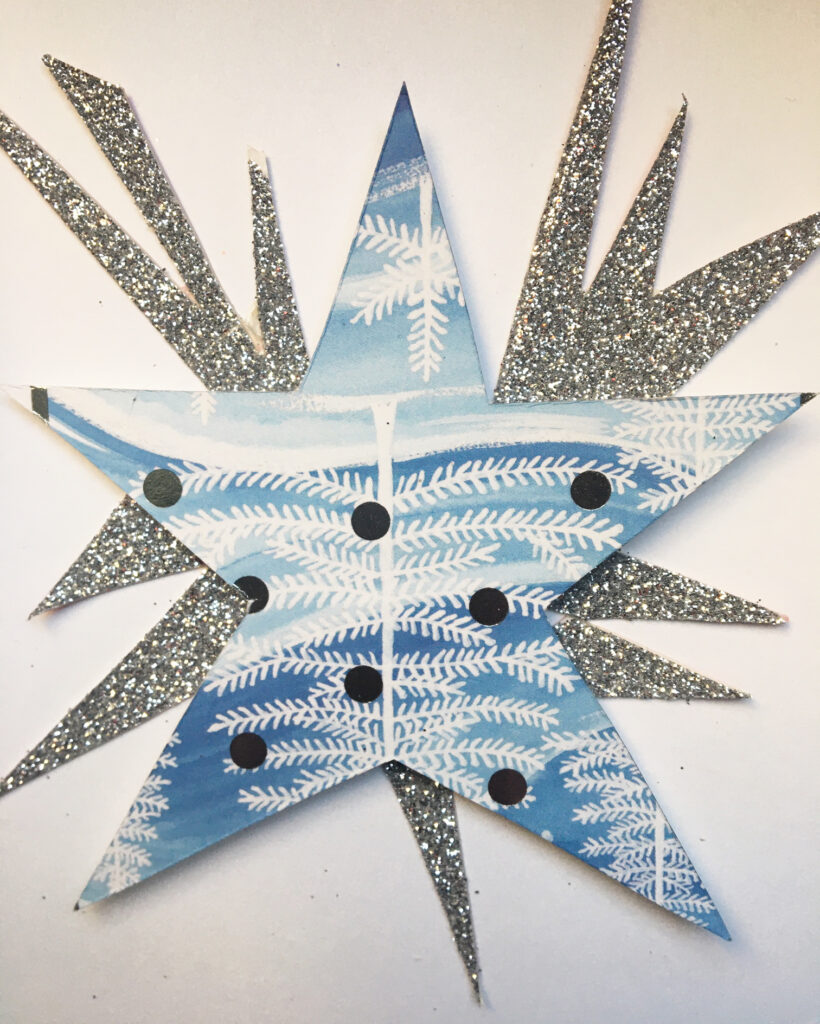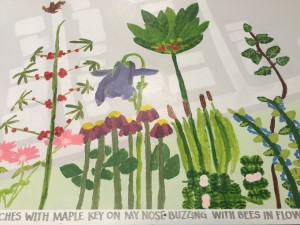This time of year always brings me back to a bit of eco-artmaking, even as the season does a deep dive into hyper-consumerism. For the past 6 years, Iāve been re-purposing old Christmas cards into new one, putting my sustainability principles and my creativity into play. In early December each year I think the same thing ā Iām too tired at the end of a busy fall to make handmade cards ā what am I thinking? And then I start to create the image, and then make each card, and it gives me a new sense of energy that carries me into the holidays. The idea is catching on, as a few of my artistic friends have picked up on the idea and are making their own. Hereās examples from years gone by ā such an easy way to show that re-thinking and re-purposing are two of the most important āRās!
Choice-based Approaches to Art Education
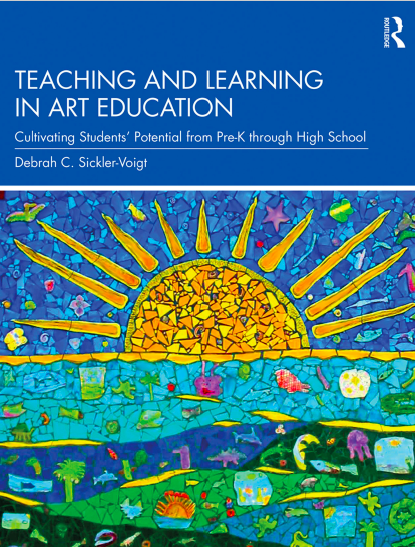
What a year this has been! The pandemic has continued to hold me back from blogging, thanks to the seismic shift to online learning and all of it new dimensions. One of my biggest challenges has been how to move my Art Education courses online ā how do I teach basic art techniques to preservice teachers, many of whom havenāt made art since their own time as elementary students? And how do I do that with no access to a common set of art materials or tools? Lots of talking with my artistic friends and fellow art educators made me realize that mailing out a set of basic tools and materials would only add to the carbon footprint of the course, which is the opposite of what Iām trying to teach. Instead, I drew inspiration from Deborah Sickler-Voigtās book Teaching and Learning in Art Education. In it, she promotes the notion of a comprehensive approach to art education, which is student-centred, inclusive, multidisciplinary, and most importantly, choice-based. What if I moved the focus away from technique and put more emphasis on mean-making? What if the tools and materials they used were based on what they had on hand at home, rather than on what I provided? I piloted this approach last spring for the first time, and taught it again this fall, with steadily improving results each time. I saw the same realization grow from week to week that my students are indeed creative beings (just like I have seen in my F2F classes), and that they could make art in lots of different ways, using a wide range of materials and techniques. Letting the ābig ideasā they feel passionate about be at the centre of the creative process ensured their buy-in, and we were all amazed at the incredible variety of artworks that resulted. We used the online app āSeeSawā to share our artworks, ensuring a rich trading of ideas between students. While I still miss learning alongside them in person, giving them more creative latitude and choice are elements Iāll keep in play in this course moving forward.
Growing Garden-based Art

Garden & EcoArt Installed! 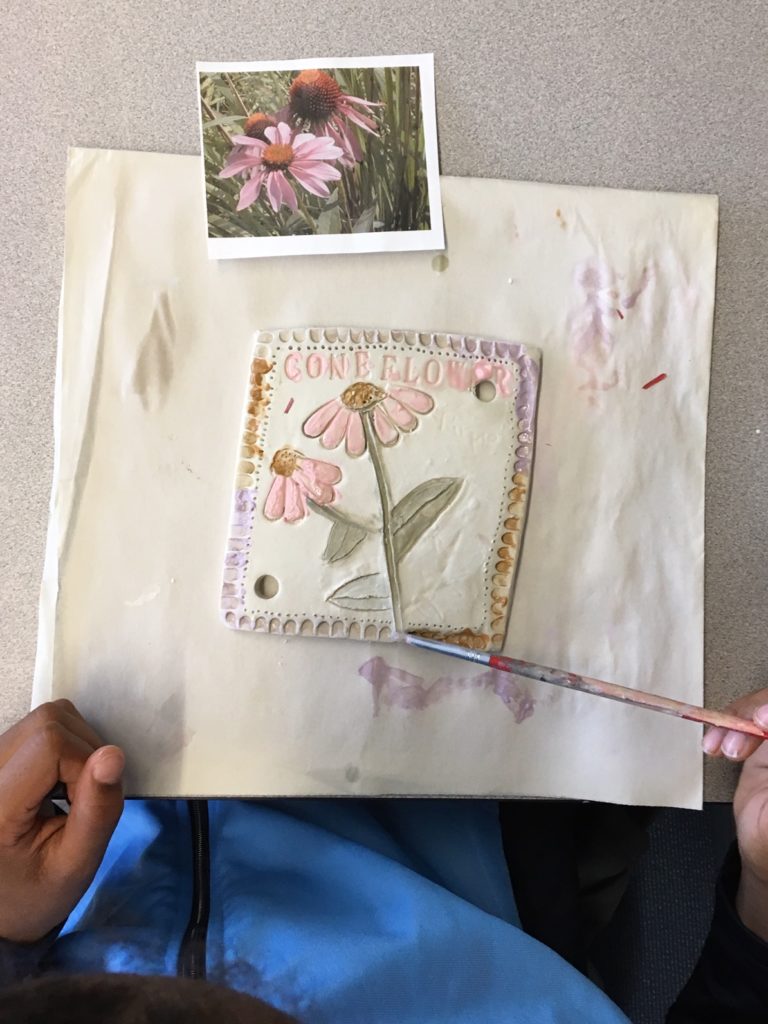
Working on glazing
With the return of spring last April, I was happy to work alongside students and teachers at Ryerson Community School (part of the Toronto District School Board) as they began to develop their school garden. They were excited to be working with one of our OISE graduate students, Mimi Ristin, to design and plant their own raised bed gardens filled with native plants, as well as to explore the types of trees in their schoolyard and local park. To help them remember the names of these plants and their benefits, we designed two art installations to share their learning with the school community. Three classes of younger children (grades 2&3) made over-sized clay leaves from native trees, and three more classes (grades 4-6) made clay relief tiles of native flowers. We used a high-fire porcelain clay (cone 6), which had a silky feel and proved to be easy for the children to work with (even though many had never worked with clay before). Rubber letters (such a great tool) were used to press the names of the flowers and trees into the tiles, effectively making these artworks into a visual field guide when installed altogether on the school fence. No doubt that having OISE teacher candidates Clara Hoover and Elena Viazmina help out made the project that much easier! Using natural materials (like clay) and installing outdoors are just two of the strategies for growing art in schoolyards – check out my new article about this in Art Education Journal in July 2019.

Making the clay leaves 
Clay leaves on the fence
Growing a Garden-Based Approach to Art Education
The gardens around schools, whether found in the schoolyard or a nearby park, can be a great way to inspire and integrate learning across the curriculum.Ā Ā I was happy to have this recognized recently by the international Art Education journal, which published āGrowing a Garden-Based Approach to Art Educationā in their July 2018 issue, and put on of the photos of the article on the cover!Ā Co-authored with OISE graduate student (now alumni) Jennifer Sharpe, we aimed to explore the joys of taking art education into the school garden as a way to inform, inspire, and celebrate studentsā creativity. Drawing on the tenets of place-based education and nature-based learning, we presented a case study of a vibrant school garden in Toronto that has been the site of childrenās artistic exploration for over a decade. We know that when art education is conducted in schoolyards and school gardens, using these spaces as sites of discovery, creativity, meaning-making, and experimentation, children are able to deepen their understanding of the natural and built world, and develop strong connections to the environments in which they live.Ā If youād like to read more, access the article at:Ā https://www.tandfonline.com/doi/full/10.1080/00043125.2018.1465318
Planting Seeds for Eco-Art in China
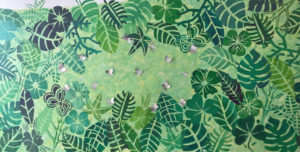 How is environmental art playing out in other parts of the world?Ā Ā I was lucky to travel to China this last spring, accompanying OISE interns as they taught in five schools in Hangzhou, a city a few hours southwest of Shanghai.Ā Ā I was impressed with the strong presence for the arts everywhere we travelled, evident in part in the gardens, architecture, public sculpture, and design of public spaces. As part of my visits to these schools, I was able to visit a few art classes, and pleased to see ālow impactā art-making being taught, inspired by traditional Chinese art forms, like paper-cutting, watercolour, and calligraphy. While I would not consider these forms of eco-art – there was no overt attention to environmental learning – they were supportive of similar tenets.Ā Ā The watercolours we saw students painting were focused on plants and wildlife; the calligraphy uses natural ink made from charcoal.Ā Ā A few of the OISE interns also put their learning about eco-art into play. They turned studentsā attention to learning about the plants and insect life in the schoolās butterfly garden.Ā Ā Drawing on their experiences working on the last few eco-art installations at OISE,
How is environmental art playing out in other parts of the world?Ā Ā I was lucky to travel to China this last spring, accompanying OISE interns as they taught in five schools in Hangzhou, a city a few hours southwest of Shanghai.Ā Ā I was impressed with the strong presence for the arts everywhere we travelled, evident in part in the gardens, architecture, public sculpture, and design of public spaces. As part of my visits to these schools, I was able to visit a few art classes, and pleased to see ālow impactā art-making being taught, inspired by traditional Chinese art forms, like paper-cutting, watercolour, and calligraphy. While I would not consider these forms of eco-art – there was no overt attention to environmental learning – they were supportive of similar tenets.Ā Ā The watercolours we saw students painting were focused on plants and wildlife; the calligraphy uses natural ink made from charcoal.Ā Ā A few of the OISE interns also put their learning about eco-art into play. They turned studentsā attention to learning about the plants and insect life in the schoolās butterfly garden.Ā Ā Drawing on their experiences working on the last few eco-art installations at OISE, 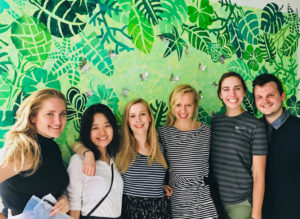 they created a beautiful homage to these by combing our butterfly installation from last year with our stencilled plant mural from this year.Ā Ā I canāt wait to see what these teacher candidates – and our Chinese hosts – accomplish movingĀ Ā forward!
they created a beautiful homage to these by combing our butterfly installation from last year with our stencilled plant mural from this year.Ā Ā I canāt wait to see what these teacher candidates – and our Chinese hosts – accomplish movingĀ Ā forward!
Diving into Water Education Through Muralling
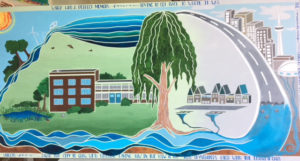
Ā Iām always looking for ways to extend my studentsā learning about eco-art education, so in addition to collaboratively creating art installations, we also take this work into schools.Ā Ā Iāve shared some of these experiences previously, but wanted to write about the most recent one focused on water education at Ryerson Community School.Ā Ā The teacher-researcher at this TDSB elementary school, Adrienne Rigler, has been immersed in water education over the past 5 years at different grade levels, often having her students share their learning about water with other classes.Ā Ā We framed this mural project as an arts-based component of the gr. 8s cross-curricular study about water.Ā Ā They learned about their local watershed, and explored the neighbourhood to ascertain its features, finding evidence of the local (and buried) Russell Creek.Ā Ā They photographed, analyzed, and sketched these watershed features, working collaboratively with myself, teacher, and teacher candidates to create a composition for the mural.Ā Ā We used a taping technique to delineate the main images, which proved to be a great way for the whole class (many of whom were hesitant to paint) to engage in the painting process. They saw the realities of their urban watershed on the right (over built, polluted water flowing into the sewers) and their dream for a healthier watershed on the left (lots of plants, animals, even a pond in their schoolyard). The result is above – what a beautiful way to share what they learned!
Playing with Gelli Printing
I’ve started playing with a new printmaking technique that has possibilities for low impact, biodegradable art-making.Ā Ā Gelli printing is an approach to monoprinting that creates one-of-a-kind prints.Ā Ā It utilizes a flexible printing matrix (or base) made out of natural materials – you can either buy one of these, or make your own using Knox gelatin powder and glycerin (the latter a less expensive option.)Ā Ā Due to its flexibility, it can capture both positive and negative impressions of items layed on the matrix.Ā Ā Laying down natural items like leaves, grasses, or ferns works beautifully, whether you lay down a base of pigment first, or after the item has gone on the matrix. This can be a great way to capture the experience of a nature walk.Ā Ā I like the effects of acrylic paint with this technique, rather than water-based print making inks, but as these aren’t particularly environmentally-friendly, I need to experiment with creating a more natural form of pigment with it. Ā Check out all of the images on Pinterest that artists have posted for Gelli printing – hopefully it will inspire you to try it yourself!
Learning about Place-based Education
We were lucky to bring in David Sobel from Antioch University toĀ OISE this past summer to do a talk and day-long workshop on place-based education.Ā Ā David is the guru of Place-Based Education (PBE), having written extensively about it in his many books (looking to Mapmaking with Children, Childhood & Nature, or Place-Based Education, to name only a few).Ā Ā Working with his partner, Jen Kramer, David led our teachers through a variety of art-based learning activities based on creative mapping, collages, and miniature worlds.Ā Ā Our teachers would be the first to tell you that they aren’t ‘artists” or ‘creative’, yet all were fully engaged in these experiences as David and Jen had us consider the places in which we grew up, and the places we live in now as a starting point to thinking about PBE.Ā Ā David’s rich set of examples of PBE, drawn from schools all over the US, inspired us with its ‘real world’ learning that can take place when using this approach – creating museum exhibits, cleaning up wetlands as just two examples. In Jen’s afternoon workshop, the teachers created beautiful collages using discarded artworks of key parts of Toronto, inspired by author’s book; a few examples are shared below.Ā Ā We ended the day feeling better prepared to tackle PBE theoretically, practically, and aesthetically!
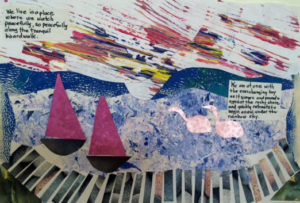

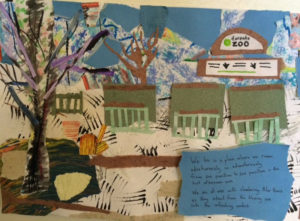
Results of the Biodiversity Mapping Project
What a busy end to the spring!Ā Ā While one group of my students was helping with the installation of our Bee the Change project, another was working alongside me and the K-8 students at Keele PS on the Biodiversity Mapping Project. The latter was a 10 day eco-art project that resulted in eight large murals for the school, acting as aesthetic responses to the children’s learning in science, art and geography over the course of four months.Ā Ā They studied the concept of biodiversity – species, ecosystems, and genetic – through research, reading, and outdoor exploration, and shared what they learned through drawing, painting, and creative map-making. Each of the murals has a similar background – a map of part of the catchment area of the school – that if put all together, show the neighbourhood around Keele.Ā Ā On the top layer is one form of life that contributes to local biodiversity, from insects (gr. 1s) through to genetic diversity (gr. 8s.) Ā Around the edge is text written by the students to act as a framing device – in some cases poetry, in other cases the names of the species depicted. Ā We worked to reduce the eco-footprint of this painting project by minimizing and collecting the painting wastewater, as well as by reusing old mural panels. The results are meaningful AND beautiful, helping the students, teachers and community members better understand the importance of local biodiversity.Ā Iām very appreciative of the opportunity to work with the wonderful teachers and students at Keele; the help from my teacher candidates was the topping on the cake!
Understanding Biodiversity Through Mural-making
How do you help elementary students understand the importance of biodiversity?Ā Ā I’ve been invited to work at a local elementary school in the spring with students in classes from grades 1 to 8, working on developing their knowledge of this complex concept through a series of murals for the school.Ā Ā But where do you start with a ‘big idea’ like this?Ā Ā I began by talking with the teachers leading the project to get an idea of what they wanted; there were parameters forĀ how they could proceed already in place. Ā Then I did some brainstorming of words, images and text for my own reference points.Ā Ā Researching was the next step; I read about and watched videos on biodiversity and looked at other artists’ works to see what has been done in theĀ past.Ā Ā All of this led to developing ideas on paper, which were revised by talking with the teachers. We have considered how to lesson the environmental impact of the murals along with this; we’re re-purposing existing panels, rather than buying new, and planning to capture all of the waste water from our acrylic paints. The planning process has been bringing together aspects of art, science and geography, and drawing on the principles of creativity and design thinking. Ā Check back in June to see how the project has developed; I’ll post our next steps and photos of the finished murals.
